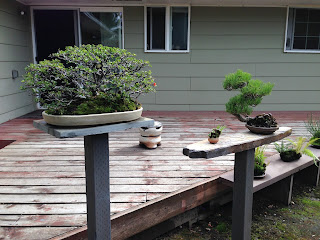This time the subject at hand is a collected Rocky Mountain Juniper that Todd collected in 2012, firmly established and ready for work. This tree features a nice trunk that is mostly deadwood and a strong branch growing near it, which the crown could be built on, but what is the challenge in that?
There is a long protruding branch on the rear side of the tree that terminates several feet away from the trunk, which has nice movement and could serve as the apex. Our mission is to re-position this branch so that it apexes over the trunk. This bend would be even more challenging than the Limber Pine in part 1 since it's very thick and not as flexible.
There appeared to be two veins feeding this branch at one time and one was mostly dead, so we opted to split the branch and remove this section.
After the section is removed, it's time to level the area.
The area is then lined with gauge 4 copper wire and wrapped in raffia.
A piece of rebar is positioned in the soil tied to secure large jack/branch bender. The jack is then secured on several pieces of deadwood.
The branch set in its final position for the day. In the spring, we'll split the base of the branch in order to eliminate the straight portion next to the trunk.



































